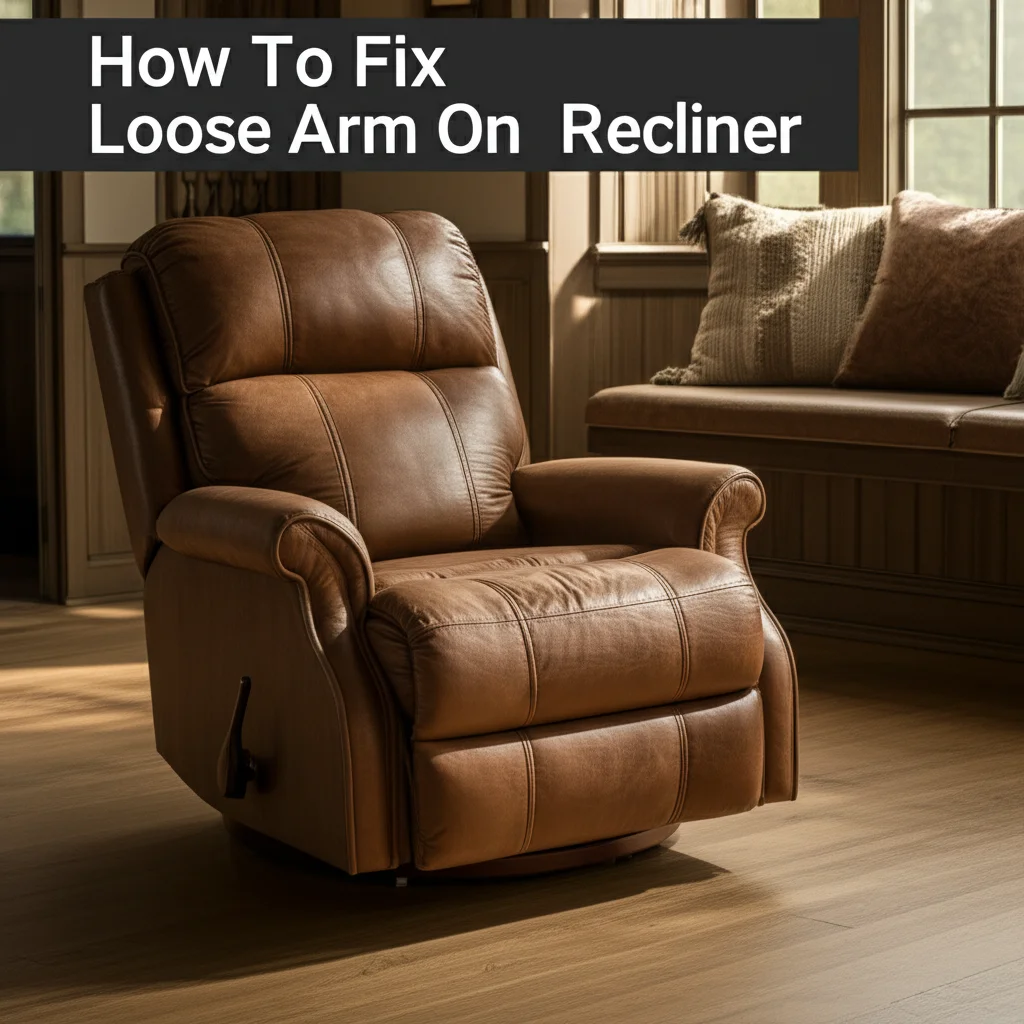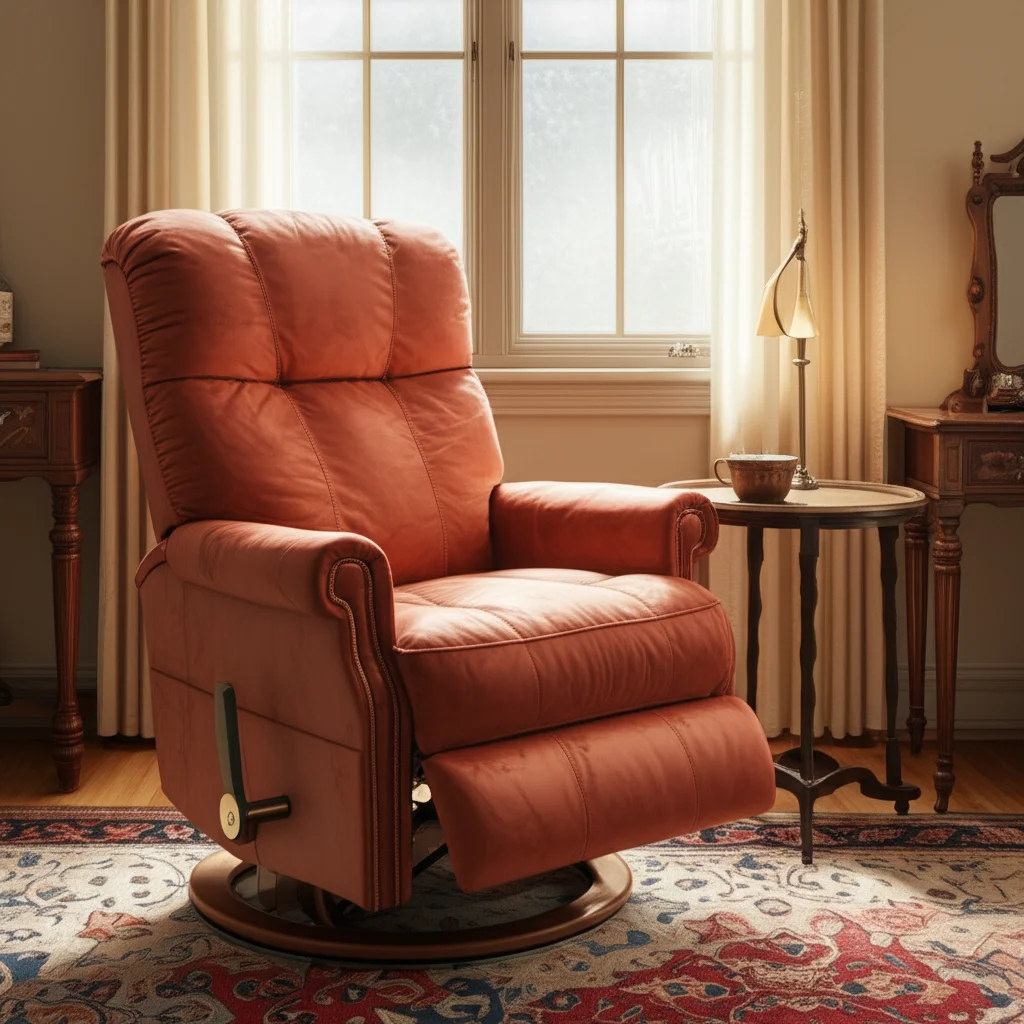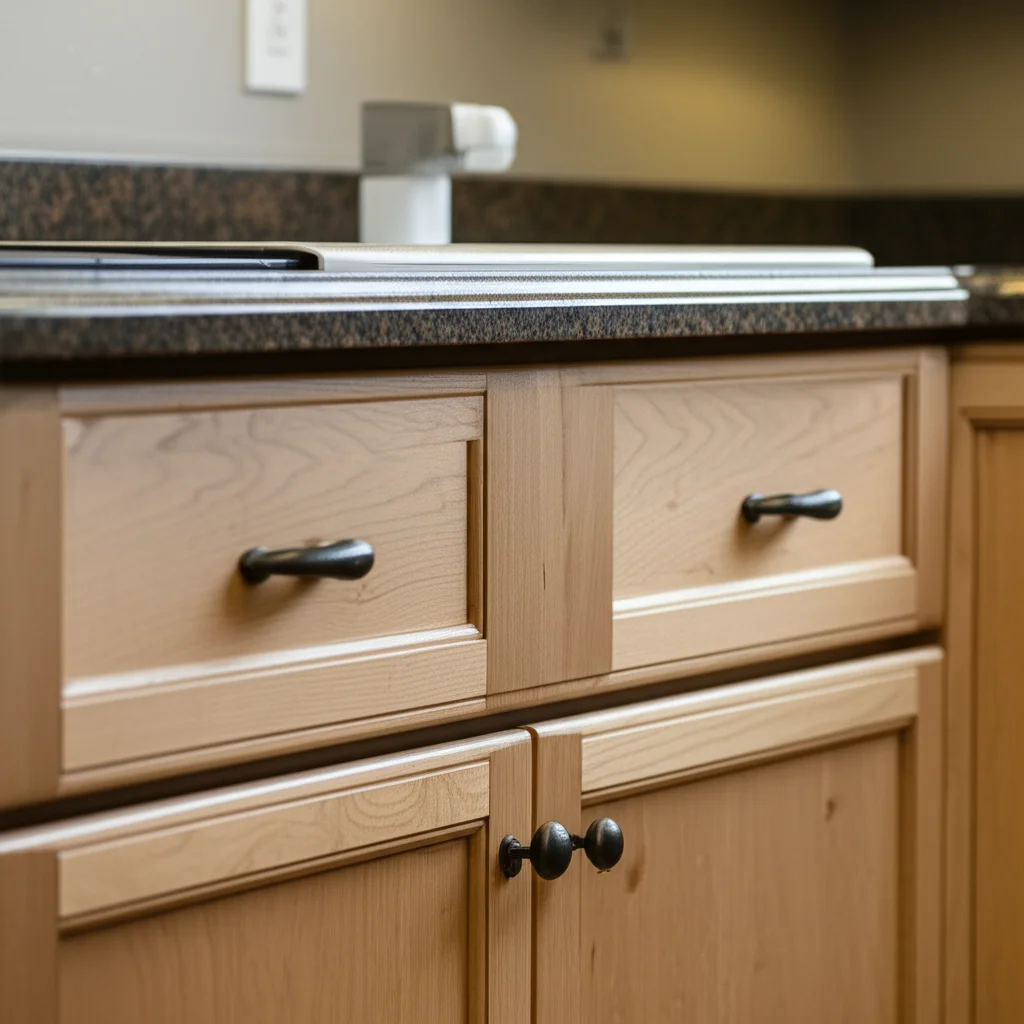· Todd Martin · Home Repair · 13 min read
How To Fix Loose Arm On Recliner

How to Fix a Loose Recliner Arm Quickly
A wobbly recliner arm can turn your favorite spot into a frustration zone. That comfortable lean you expect suddenly feels unstable. A loose arm compromises both your comfort and the safety of your recliner. My goal is to guide you on how to fix loose arm on recliner chairs. You can bring back the stability and joy of your recliner.
This article provides simple, actionable steps. We will cover common causes, essential tools, and various repair methods. You can tackle this common furniture problem yourself. Let us get your recliner feeling solid once again.
Takeaway
You can fix a loose recliner arm.
- Identify the type of arm attachment.
- Gather basic tools like screwdrivers and wrenches.
- Tighten visible fasteners first.
- Access hidden connections if needed by removing upholstery.
- Repair stripped holes or damaged wood with simple techniques.
- Consider reinforcement for lasting stability.
You can fix a loose recliner arm by checking and tightening all screws, bolts, and nuts that attach the arm to the recliner’s frame. For hidden connections, carefully remove upholstery panels to access internal fasteners. If wood is damaged or screw holes are stripped, repair them using wood filler, dowels, or new hardware for a lasting solution.
Understanding Recliner Arm Looseness
It feels annoying when your recliner arm starts to wobble. Why does this happen? The most common reason is simply regular use. Over time, the constant pressure and movement put stress on the recliner’s parts. This leads to screws, bolts, or nuts becoming loose.
Different recliners have varying attachment methods for their arms. Some arms bolt directly to the frame. Others might use brackets or even integrated wooden structures. Understanding how your specific recliner is built helps you locate the source of the problem. A loose recliner arm often signals a need for basic tightening.
The internal frame structure can also be a factor. Many recliners use a combination of wood and metal for their frame. If the wood itself starts to degrade, or the metal brackets bend, the arm will feel unstable. This is more than just a loose screw. Sometimes, the problem comes from the main mechanism. If the reclining function strains the arms, it can cause them to loosen.
Regular inspection of your recliner’s arms can prevent major issues. Look for any visible gaps where the arm meets the chair body. Listen for creaking sounds when you apply pressure. Early detection can make the repair process much easier. Identifying the cause is the first step in fixing a loose arm on a recliner.
Gathering Your Recliner Repair Tools
Before you begin any repair, you need the right tools. Having everything ready makes the job smoother and faster. Most of the items you need are standard household tools. You might already own them.
You will likely need a set of screwdrivers. This includes both Phillips head and flathead types. A socket wrench set or an adjustable wrench is also essential. These help tighten bolts and nuts. A flashlight will be very helpful. It lets you see into tight, dark spaces under or inside the recliner.
Consider having some wood glue and wood filler on hand. These are crucial if you find stripped screw holes or damaged wood. Clamps can also be useful for holding glued parts while they dry. A pair of pliers can help grip small parts. Safety glasses are always a good idea when working on furniture. They protect your eyes from dust or flying debris.
Sometimes, you might need replacement hardware. Keep some extra screws or bolts in various sizes if old ones are stripped or missing. Having these tools ready saves you from stopping halfway through the repair. I always make sure my workspace is clear before I start. This way, I can focus on the task of fixing the loose arm on the recliner.
Tightening Visible Recliner Arm Fasteners
When a recliner arm feels loose, the first step is always to check for visible fasteners. This is often the simplest fix. Many recliners have exposed screws, bolts, or nuts around the base or sides of the arms. These connect the armrests to the main chair frame.
Start by carefully inspecting the entire arm. Look along the bottom edge, the back where it meets the chair, and even underneath the armrest. You might need to tilt the recliner or shine a flashlight into hidden areas. Once you spot any fasteners, gently try to tighten them using the appropriate screwdriver or wrench. Do not overtighten, as this can strip the screws or damage the wood. Just make them snug.
Some recliners might have decorative caps covering the screw heads. You can usually pry these off with a flathead screwdriver. Be gentle to avoid scratching the recliner’s finish. After tightening, replace the caps. If you find a screw that spins without tightening, the screw hole might be stripped. This needs a different approach, which we will discuss later.
This basic inspection and tightening can resolve many loose arm issues. It is the quickest way to restore stability. I always start here because it is the easiest solution. Often, this simple step is all it takes to get your recliner feeling solid again.
Exploring Hidden Recliner Arm Connections
Sometimes, tightening visible fasteners does not fix the problem. This means the looseness is likely coming from hidden connections. Many recliners have internal mechanisms or fasteners that secure the arms. These are usually beneath the upholstery. Accessing them requires a bit more effort.
You will need to carefully examine the recliner for panels that can be removed. Look for zippers, Velcro strips, or staples holding fabric in place. Often, there are access panels at the back or underside of the recliner. If you see staples, you might need a staple remover or a flathead screwdriver to gently pry them out. Be careful not to tear the fabric.
Once you gain access, you will likely see the recliner’s wooden or metal frame. The arms are usually bolted or screwed directly to this internal structure. Look for any loose nuts or bolts within this framework. Use your wrench or screwdriver to tighten them. Pay attention to the joints where the arm connects to the seat and backrest frame. These areas often bear significant stress.
You might find springs or linkages that are part of the reclining mechanism itself. Ensure these components are securely attached and not bent. A loose spring or connection here can cause a ripple effect, leading to instability in the arm. If you are struggling with a recliner’s inner workings, you might find it helpful to look at how different components operate. Sometimes, issues like an electric recliner that won’t close share underlying mechanical principles. See our guide on how to fix an electric recliner that won’t close for related insights. It is a bit like looking inside the chair’s skeleton.
When you are finished, carefully reattach any fabric panels or upholstery. Use a staple gun if you removed staples, or re-secure with Velcro or zippers. Take your time with this step to ensure a neat finish. This method often solves more stubborn loose arm issues that visible fasteners cannot address. Also, for general chair stability, understanding how springs work can be useful; our article on how to fix springs in a chair offers relevant information.
Fixing Stripped Holes and Wood Damage
Sometimes, tightening screws does not work because the screw hole is stripped. This means the wood inside the hole can no longer grip the screw threads. This is a common problem, especially in older or heavily used recliners. You can fix this issue.
One method is to use wood filler. Apply wood filler into the stripped hole. Let it dry completely according to the product instructions. Once dry, you can re-drill a small pilot hole. Then, reinsert the original screw. The filler provides a new, solid base for the screw to grip.
Another effective technique involves using small wooden dowels or toothpicks. Dip a few wooden toothpicks or a small dowel in wood glue. Insert them into the stripped hole until it is tightly packed. Break off any excess wood flush with the surface. Let the glue dry completely. The wood and glue expand, creating a snug fit for the screw. Then, you can drive the screw back into the reinforced hole. This method works very well for small stripped areas. If you’re dealing with issues like a stripped screw hole in a wood chair, the principles are very similar to what you’d apply here.
What if the wood frame itself is cracked or broken? This is a more serious issue but still often fixable. Apply wood glue generously into the crack. Use clamps to hold the pieces tightly together while the glue dries. Ensure the pieces align perfectly. Let the glue cure for at least 24 hours. For significant damage, you might need to add a small reinforcing block of wood. Glue and screw this block across the damaged area for extra strength. For larger furniture wood repairs, consider our guide on how to fix a crack in wood furniture for broader techniques. Also, if you’re dealing with wood that’s swollen from moisture, it might compromise the screw’s grip, and our guide on how to fix water damaged swollen wood furniture could provide useful insights. These repairs make sure the recliner arm stays firmly attached for a long time.
Boosting Recliner Arm Stability Permanently
After tightening fasteners and repairing any damaged wood, you might want to consider reinforcement. This helps ensure your recliner arm stays stable for a long time. It can prevent future looseness, especially if your recliner gets heavy use. Reinforcement adds an extra layer of durability.
One simple way to reinforce is by adding corner blocks. These are small triangular or L-shaped pieces of wood. You can screw and glue them into the inner corners where the arm frame connects to the seat or back frame. This creates a stronger, more rigid joint. Ensure the blocks do not interfere with any reclining mechanisms. They provide excellent support for the arm.
Another option is to use metal L-brackets. These small metal plates with two perpendicular sides can be screwed into the wood frames on both sides of a joint. They offer very strong support. Place them strategically where the arm joins the main frame. Again, make sure they do not impede movement or become visible from the outside. These brackets add significant structural integrity.
Applying wood glue to joints during reassembly is also effective. Even if screws hold the pieces, a thin bead of wood glue along the seams before tightening adds strength. The glue acts as an additional bonding agent, preventing micro-movements that can lead to looseness over time. This creates a solid, permanent bond.
Regular maintenance is key to long-term stability. Periodically check all fasteners on your recliner. A quick tighten every few months can prevent arms from becoming noticeably loose. Keep the area around the recliner clean. Avoid putting excessive weight or pressure directly on the armrests when getting in or out of the chair. These simple steps ensure your recliner remains comfortable and stable for years. You can enjoy your repaired recliner knowing it is secure.
Knowing When to Seek Professional Help
Sometimes, a DIY fix is not enough. You might encounter situations where the damage is too extensive. Or, the internal mechanisms are too complex for a home repair. Knowing when to call a professional can save you time and prevent further damage. It is important to recognize your limits.
If the main frame of the recliner is broken, not just a small crack, it is likely time for an expert. Extensive frame damage often requires specialized tools and knowledge. Attempting to fix a major structural issue without proper experience can lead to an unsafe recliner. Professional furniture repair technicians have the skills to handle these larger repairs.
If you have an electric recliner and the arm issue seems connected to the electrical or motor components, it is best to consult a professional. These systems can be intricate. Tampering with them without knowledge could cause more problems. An expert can diagnose electrical or mechanical failures correctly.
Consider the cost versus replacement value. If the repair cost approaches the price of a new recliner, buying a new one might be more practical. Get a quote from a professional first. This helps you make an informed decision. Sometimes, a beloved recliner is worth the investment in professional repair, even if it costs a bit more.
A professional can offer a long-lasting solution for complex issues. They often use higher-grade materials or techniques not available to the average DIYer. If you have tried all the steps above and the arm is still loose, or if you feel uncomfortable tackling the repair, do not hesitate to reach out to a furniture repair specialist. They can restore your recliner safely and efficiently.
FAQ Section
Q1: How do I know if my recliner arm is loose?
You will notice the arm wobbles or shifts when you lean on it. It might also make creaking or rattling sounds. Visually, you might see small gaps appearing where the arm meets the chair’s main body. These are clear signs of looseness.
Q2: Can all recliner arm types be fixed?
Most recliner arm types can be fixed. Common issues like loose fasteners, stripped screw holes, or minor wood cracks are usually repairable. However, extensive frame damage or complex internal mechanism failures might require professional help or replacement.
Q3: What if I can’t find the screws?
Many recliners have hidden fasteners. Look for zippers, Velcro strips, or stapled fabric panels on the back or underside of the recliner. Carefully remove these to access the internal frame and arm attachments. Use a flashlight to see into dark areas.
Q4: Is it safe to use wood glue on recliner arms?
Yes, using wood glue is safe and effective for repairing cracks or reinforcing joints. It provides a strong, lasting bond for wooden components. Ensure you use a good quality wood glue and allow sufficient drying time, typically 24 hours, for the strongest bond.
Q5: How often should I check my recliner for looseness?
I recommend checking your recliner’s arms and other components every six to twelve months. This quick inspection can help you spot minor looseness early. Addressing issues promptly prevents them from worsening and becoming more challenging to fix.
Q6: What’s the average cost of professional recliner arm repair?
The cost varies based on damage severity and location. Simple tightening might be inexpensive. More complex repairs involving frame work or upholstery could cost $100-$300 or more. Always get a quote from a local furniture repair service before deciding.
Conclusion
A loose arm on your favorite recliner does not have to mean buying a new one. I hope this guide has shown you how to fix loose arm on recliner chairs. You can bring back stability and comfort to your chair. From simple tightening of visible fasteners to repairing stripped holes and reinforcing joints, many solutions are within your reach.
Taking the time to understand your recliner’s construction and applying the right techniques can make a big difference. Remember to gather your tools, work carefully, and address any wood damage. Reinforcement can provide lasting stability. If the problem is too big, professional help is always an option. You can enjoy your recliner again, knowing it is secure. Get comfortable and relax!





